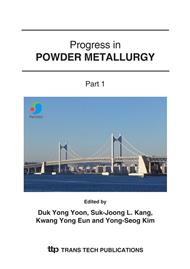p.709
p.713
p.717
p.721
p.725
p.729
p.733
p.737
p.741
Sintered Structural Cu-Ni-Mo-C Low Alloyed Steels with Small Niobium Additions
Abstract:
This paper investigates the possibilities of niobium using for the mechanical properties of the common low alloyed Cu-Ni-Mo-C structural sintered steels enhancing by a similar technique with that used in the classical HSLA steels obtaining. For this purpose, both thermodynamic and experimental investigations were carried out, their results showing that the added Nb to these steels form at sintering in a nitrogen containing atmosphere, rather then the other alloying elements, carbides, nitrides, carbonitrides. They are solved in austenite and precipitate at the sintered steels cooling / artificial aging, forming precipitates of an expected strengthening effect. The results for 0.2 ÷ 1.0 % fine Nb powder and 0.3 % graphite additions to Distaloy AB powder cold compacted and sintered in dissociated ammonia proved that such a strengthening effect, which leads to higher mechanical properties of the processed steels than of the Cu-Ni-Mo-C ones, can be achieved.
Info:
Periodical:
Pages:
725-728
Citation:
Online since:
January 2007
Authors:
Price:
Сopyright:
© 2007 Trans Tech Publications Ltd. All Rights Reserved
Share:
Citation:


